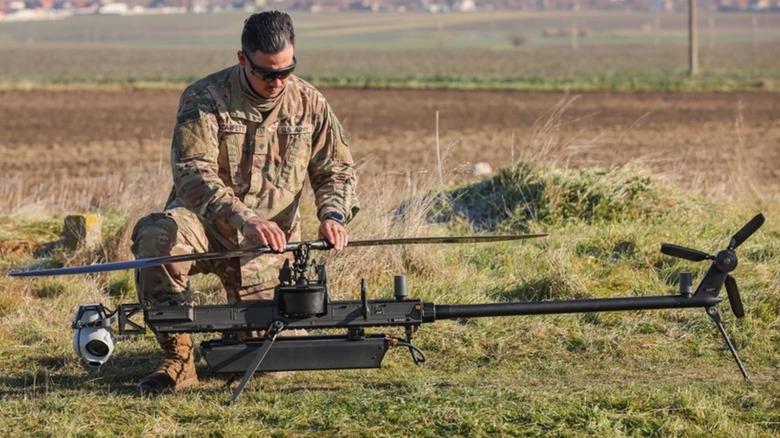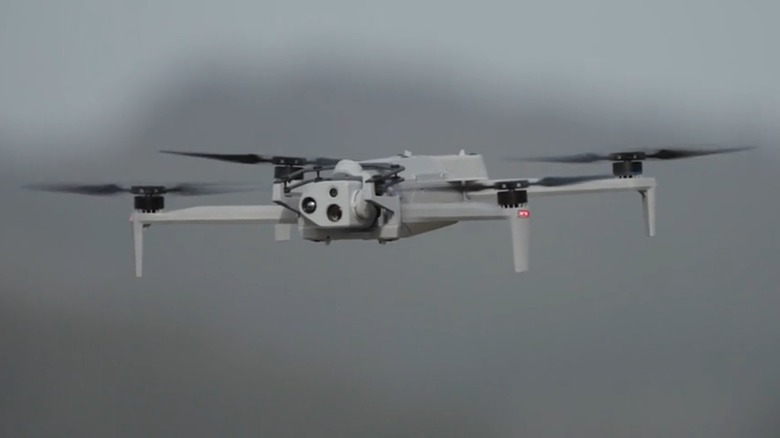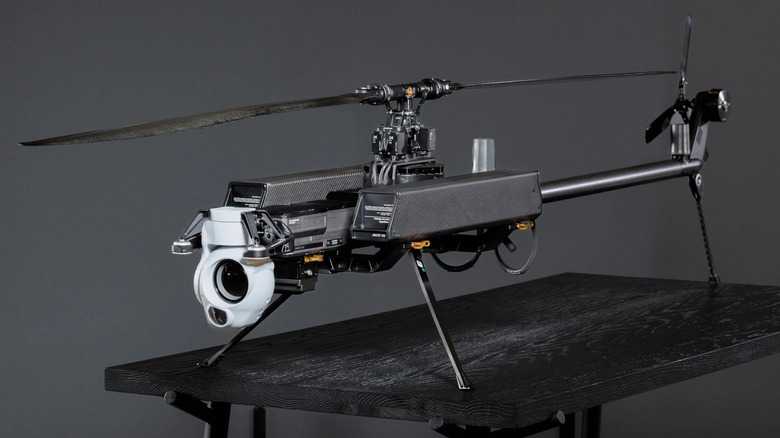Meet The New Military Drones Being Integrated Into U.S. Army Companies & Battalions
If combat throughout the 21st century has taught military planners anything, it's that drones are the way of the future. Across battlespaces, the world over, militaries, insurgencies, and others have employed a wide variety of unmanned vehicles for a variety of purposes, and the technology is constantly evolving. In the U.S. military, drones were initially quite large; aircraft like the MQ-1 Predator and the much larger MQ-9 Reaper are full-size aircraft, while the RQ-4 Global Hawk is quite massive.
Those are theater-level assets, serving entire warzones, but they aren't the only drones operating for the U.S. Smaller drones like the RQ-7 Shadow and others have been used by smaller units, and innovation along those lines continues. In November 2024, the U.S. Army began testing two new drones attached to battalions and their companies. These are the Skydio X10D quadcopter and the Ghost-X, which are formed similarly to a traditional helicopter. Both new drones were field tested by Delta Company, 317th Brigade Engineer Battalion (BEB).
Testing of this type is common in the U.S. military, and should the drones prove useful, they will likely go through several modifications to further meet field commanders' mission requirements. Unlike the aforementioned larger Unmanned Aircraft Systems (UAS), the Skydio X10D and Ghost-X are considerably smaller and have shorter flight endurances, a short range, and other limitations that make them ideal for only a handful of missions. Still, the information they could provide to commanders on the ground will likely improve battlespace situational awareness and mission success.
The Skydio X10D
The Skydio X10D is a Short Range Reconnaissance (SRR) aircraft capable of flying for 30 minutes to a distance of between 1.9 and 3.1 miles. The system is designed for dismounted infantry and scout patrols to provide situational awareness of a unit's immediate area to properly plan maneuvers. While it looks like a standard quadcopter available for consumers, it boasts a robust system of sensors and advanced controls you're not going to find off-the-shelf or on Amazon.com.
The X10D can fly up to 45 mph, be deployed in under 40 seconds, operate in high-dust and wet environments, and feature onboard artificial intelligence capabilities. Its optical sensors are modular and include radiometric thermal and high-resolution visual cameras. The SRR drone's telephoto camera can detect enemy personnel and vehicles up to 7.5 miles away, recognize them at 2.2 miles, and identify them at 0.8 miles, extending its visual abilities beyond its range capabilities.
The onboard AI improves flight operations, as the X10D can identify and recognize its surroundings and automate data capture — this ability improves over time. This allows for automatic obstacle avoidance, improving an operator's focus on data collection about their environment. Additionally, several functions can be automated, including following persons of interest, providing mobile overwatch, and constructing 2D and 3D maps in real time. All of these capabilities suggest the X10D is potentially a (relatively) low-cost, high-value SRR that will be easily deployable by a wide range of military units operating in dangerous, austere environments.
The Ghost-X
The Ghost-X is a Medium Range Reconnaissance (MRR) drone with a range of 15.5 miles. It boasts a flight time of 75 minutes and has onboard sensors capable of providing commanders with local intelligence, surveillance, and reconnaissance (ISR) across a wide area. The system is packed into a tactical soft case and can be made ready for flight by a single operator in fewer than two minutes without the need for any tools, making it highly portable and easily deployable.
Ghost-X's onboard computer AI can autonomously detect, classify, and track vehicles and personnel while avoiding terrain and other obstacles without operator direction. Additionally, it can carry 20 pounds, allowing it to bear a variety of onboard sensors for ISR to support numerous mission requirements. Operators can instruct the Ghost-X via a point-and-click interface to operate in specific areas, providing overwatch from a safe standoff distance. The MRR's Edge Performance "Leverages AI, computer vision, and sensor fusion algorithms to autonomously detect, classify, and track objects of interest in low-bandwidth and contested environments."
These capabilities all come together to enable the asset to function in austere environments while providing commanders on the ground with more information than previous similarly-sized drones. It takes a single class to learn how to operate, making it easy to use with limited training. Should the U.S. military adopt the Ghost-X, it will significantly improve situational awareness in a variety of combat operations, ideally maximizing capabilities while minimizing the danger to troops on the ground.


